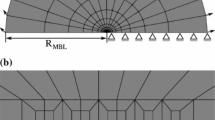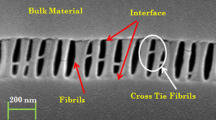Abstract
The time dependence of fracture has two sources: (1) the viscoelasticity of material behavior in the bulk of the structure, and (2) the rate process of the breakage of bonds in the fracture process zone which causes the softening law for the crack opening to be rate-dependent. The objective of this study is to clarify the differences between these two influences and their role in the size effect on the nominal strength of stucture. Previously developed theories of time-dependent cohesive crack growth in a viscoelastic material with or without aging are extended to a general compliance formulation of the cohesive crack model applicable to structures such as concrete structures, in which the fracture process zone (cohesive zone) is large, i.e., cannot be neglected in comparison to the structure dimensions. To deal with a large process zone interacting with the structure boundaries, a boundary integral formulation of the cohesive crack model in terms of the compliance functions for loads applied anywhere on the crack surfaces is introduced. Since an unopened cohesive crack (crack of zero width) transmits stresses and is equivalent to no crack at all, it is assumed that at the outset there exists such a crack, extending along the entire future crack path (which must be known). Thus it is unnecessary to deal mathematically with a moving crack tip, which keeps the formulation simple because the compliance functions for the surface points of such an imagined preexisting unopened crack do not change as the actual front of the opened part of the cohesive crack advances. First the compliance formulation of the cohesive crack model is generalized for aging viscoelastic material behavior, using the elastic-viscoelastic analog (correspondence principle). The formulation is then enriched by a rate-dependent softening law based on the activation energy theory for the rate process of bond ruptures on the atomic level, which was recently proposed and validated for concrete but is also applicable to polymers, rocks and ceramics, and can be applied to ice if the nonlinear creep of ice is approximated by linear viscoelasticity. Some implications for the characteristic length, scaling and size effect are also discussed. The problems of numerical algorithm, size effect, roles of the different sources of time dependence and rate effect, and experimental verification are left for a subsequent companion paper.
Similar content being viewed by others
References
Aleksandrov, A.P. and Zhurkov, S.N. (1933). Yavlenie Khrupkogo Razryva (The Phenomenon of Brittle Fracture). GTTI Press, Moscow.
Barenblatt, G.I. (1959). The formulation of equilibrium cracks during brittle fracture. General ideas and hypotheses. Axially-symmetric cracks. Journal of Applied Mathematics and Mechanics (PMM) 23, 622–636.
Barenblatt, G.I. (1962). The mathematical theory of equilibrium cracks in brittle fracture. Advances in Applied Mechanics 7, 55–129.
Barenblatt, G.I., Entov, V.M. and Salganik, R.L. (1970). Some problems of the kinetics of crack propagation. Inelastic Behavior of Solids (Edited by M.L. Kanninen et al.), McGraw-Hill, New York, 559–585.
Bažant, Z.P. (ed.). (1988). Mathematical modeling of creep and shrinkage of concrete. John Wiley, New York-Chichester, chapter 2.
Bažant, Z.P. (1993). Current status and advances in the theory of creep and interaction with fracture. Proc. 5th International RILEM Symposium on Creep and Shrinkage of Concrete (ConCreep 5) (held at U.P.C., Barcelona, September), (Edited by Z.P. Bažant and I. Carol, E and FN Spon), London, 291–307.
Bažant, Z.P. (1994). Creep and thermal effects in concrete structures: A conspectus of some new developments. Proc., Computational Modelling of Concrete Structures (EURO-C), held at Innsbruck, Austria, March, Pineridge Press, 461–480.
Bažant, Z.P. (1995a). Creep and damage in concrete. Materials Science of Concrete IV (Edited by J. Skalny and S. Mindess), Am. Ceramic. Soc., Westerville, OH, 355–389.
Bažant, Z.P. (1995b). Scaling of quasibrittle fracture and the fractal question. ASME Journal of Materials and Technology 117, 361–367.
Bažant, Z.P. (1996a). Internal research note, Northwestern University.
Bažant, Z.P. (1996b). Analysis of work-of-fracture method for measuring fracture energy of concrete. ASCE Journal of Engineering Mechanics 122(2), 138–144.
Bažant, Z.P. (1997). Scaling of quasibrittle fracture: Asymptotic analysis. International Journal of Fracture 83, 19–40.
Bažant, Z.P., Bai, S.-P. and Gettu, R. (1993). Fracture of rock: Effect of loading rate. Engineering Fracture Mechanics 45, 393–398.
Bažant, Z.P. and Cedolin, L. (1991). Stability of Structures: Elastic, Inelastic, Fracture and Damage Theories, Oxford University Press, New York.
Bažant, Z.P. and Chen, E.-P. (1997). Scaling of Structural Failure. Report SAND96-2948-UC-703, Sandia National Laboratories, Albuquerque, New Mexico; also Applied Mechanics Reviews ASME 50, (10), 593–627.
Bažant, Z.P. and Chern, J.-C. (1985). Concrete creep at variable humidity: Constitutive law and mechanism. Materials and Structures (RILEM, Paris), 18, 1–20.
Bažant, Z.P. and Chern, J.-C. (1985). Strain-softening with creep and exponential algorithm. Journal of Engineering Mechanics ASCE 111(EM3), 391–415.
Bažant, Z.P. and Gettu, R. (1992). Rate effects and load relaxation: Static fracture of concrete. ACI Materials Journal 89(5), 456–468.
Bažant, Z.P., Gu, W.H. and Faber, K. (1995). Softening reversal and other effects of a change in loading rate on fracture of concrete. ACI Materials Journal 92, 3–9.
Bažant, Z.P. and Jirásek, M. (1993). R-curve modeling of rate and size effects in quasibrittle fracture. International Journal of Fracture 62, 355–373.
Bažant, Z.P. and Kazemi, M.T. (1990a). Determination of fracture energy, process zone length and brittleness number from size effect, with application to rock and concrete. International Journal of Fracture 44, 111–131.
Bažant, Z.P. and Kazemi, M.T. (1990b). Size effect in fracture of ceramics and its use to determine fracture energy and effective process zone length. Journal of American Ceramic Society 73(7), 1841–1853.
Bažant, Z.P. and Li, Y.-N. (1995). Stability of cohesive crack model: Part I-Energy principles. Trans. ASME. Journal of Applied Mechanics 62, 959–964.
Bažant, Z.P. and Li, Y.-N. (1995). Stability of cohesive crack model: Part II-Eigenvalue analysis of size effect on strength and ductility of structures. Trans. ASME. Journal of Applied Mechanics 62, 965–969.
Bažant, Z.P. and Oh, B.H. (1983). Crack band theory for fracture of concrete. Material and Structures 16, 155–177.
Bažant, Z.P. and Ožbolt, J. (1990). Nonlocal microplane model for fracture, damage, and size effect in structures. Journal of Engineering Mechanics ASCE 116(11), 2484–2504.
Bažant, Z.P., Ožbolt, J. and Eligehausen, R. (1994). Fracture size effect: review of evidence for concrete structures. Journal of Structural Engineering ASCE 120(8), 2377–2398.
Bažant, Z.P. and Prasannan, S. (1989). Solidification theory for concrete creep. ASCE Journal of Engineering Mechanics 115(8), 1691–1725.
Bažant, Z.P. and Prat, P. (1988). Effect of temperature and humidity on fracture energy of concrete. ACI Materials Journal 85, 262–271.
de Borst, R. (1987). Smeared cracking, plasticity, creep and thermal loading — A unified approach. Computer Methods in Applied Mechanics and Engineering 62, 89–110.
Carol, I. and Bažant, Z.P. (1993). Viscoelasticity with aging caused by solidification of nonaging constituent. Journal of Engineering Mechanics, ASCE, 119(11), 2252–2269.
Cherepanov, G.P. (1979). Mechanics of brittle fracture. McGraw Hill, New York (translation from Russian, Nauka Press, Moscow 1974), 354–356.
Dugdale, D.S. (1960). Yielding of steel sheets containing slits. Journal of the Mechanics and Physics of Solids 8, 100–104.
Evans, A.G. and Fu, Y. (1984). The mechanical behavior of alumina. Fracture in Ceramic Materials, Noyes Publications, Park Ridge, N.J., 56–88.
Freund, L.B. (1990). Dynamic Fracture Mechanics, Cambridge University Press, New York.
Glasstone, S., Laidler, K.J. and Eyring, H. (1941). The Theory of Rate Processes, McGraw Hill, New York.
Hillerborg, A., Modéer, R.M. and Petersson, P.-E. (1976). Analysis of crack formation and crack growth in concrete by means of fracture mechanics and finite elements. Cement and Concrete Research 6, 773–782.
Hufferd, W.L. et al. (1975). On the fracture of viscoelastic materials. CPIA Publications 264, 339–356.
Kanstad, T. (1990). Nonlinear Analysis Considering Time-Dependent Deformation and Capacity of Reinforced and Prestressed Concrete, Dr.-Ing. Dissertation, Norwegian Institute of Technology, University of Trondheim, Norway.
Knauss, W.G. (1970). Delayed failure — The Griffith problem for linearly viscoelastic materials. International Journal of Fracture 6, 7–20.
Knauss, W.G. (1989). Time dependent fracture of polymers. Advances in Fracture Research 4, 7th International Conference on Fracture, Houston, Texas, 2683–2711.
Knauss, W.G. (1993). Time dependent fracture and cohesive zones. Journal of Engineering Materials and Technology, Trans. ASME 115, 262–267.
Knauss, W.G. (1993). Crack propagation in a nonlinearly viscoelastic solid with relevance to adhesive bond failure. Journal of Applied Mechanics ASME 60, 793–801.
Laheru, K.L. (1980). Crack growth initiation and propagation in inertly pressurized and in fired subscale rocket motors. CPIA Publications 331, 267–279.
Li, Y.-N. and Bažant, Z.P. (1997). Cohesive crack model with rate-dependent crack opening and viscoelasticity: II. Numerical algorithm, behavior and size effect. International Journal of Fracture 86, 267–288.
McCartney, L.N. (1988). Crack-growth predictions for viscoelastic materials exhibiting non-uniform craze deformation. International Journal of Fracture 37, 279–301.
Nuismer, R.J. (1974). On the governing equation for quasi-static crack growth in linearly viscoelastic materials. Journal of Applied Mechanics ASME. 41, 631–634.
Petersson, P.-E. (1981). Crack Growth and Development of Fracture Zones in Plain Concrete and Similar Materials, Doctoral Dissertation, Lund Institute of Technology, Sweden.
Schapery, R.A. (1975). A theory of crack initiation and growth in viscoelastic media. International Journal of Fracture 11, 141–159.
Schapery, R.A. (1978). A method for predicting crack growth in nonhomogeneous viscoelastic media. International Journal of Fracture 14, 293–309.
Schapery, R.A. (1980). Nonlinear fracture analysis of viscoelastic composite materials based on generalized J-integral theory. Composite Materials (Edited by K. Kawata and T. Akasaka), Japan Society for Composite Materials Tokyo, 171–180.
Schapery, R.A. (1982). Models for damage growth and fracture in nonlinear viscoelastic particulate composites. Proc., 9th U.S. National Congress of Applied Mechanics, Am. Soc. of Mechanical Engineers (ASME) Book No. H00228, 237–247.
Schapery, R.A. (1984). Correspondence principles as a generalized J-integral for large deformation and fracture analysis of viscoelastic media. International Journal of Fracture 25, 195–223.
Schapery, R.A. (1989). On the mechanics of crack closing and bonding in linear viscoelastic media. International Journal of Fracture 39, 163–183.
Sluys, L.J. (1992). Wave Propagation, Localization and Dispersion in Softening Solids, Dissertation, Delft University of Technology, Delft, The Netherlands.
Tada, H., Paris, P.C. and Irwin, G.R. (1985). Stress analysis of cracks handbook, Del Research Corp., Hellertown, Pa.
Tandon, S., Faber, K.T., Bažant, Z.P. and Li, Y.-N. (1995). Cohesive crack modeling of influence of sudden changes in loading rate on concrete fracture. Engineering Fracture Mechanics 52(6), 987–997.
Thouless, M.D., Hsueh, C.H. and Evans, A.G. (1983). A damage model for creep crack growth in polycrystals. Acta Metallurgica 31, 1675–1685.
Tvergaard, V. and Needleman, A.J. (1992). Effect of crack meandering on dynamic, ductile fracture. Journal of the Mechanics and Physics of Solids 40, 447–471.
Tvergaard, V. and Hutchinson, J.W. (1992). The relation between crack growth resistance and fracture process parameters in elastic-plastic solids. Journal of the Physics and Mechanics of Solids 40, 1377–1397.
Tvergaard, V. and Hutchinson, J.W. (1994). Effect of T-stress on Mode I crack growth resistance in a ductile solid. International Journal of Solids and Structures 31, 823–833.
Williams, M.L. (1963). The fracture of viscoelastic material. Fracture of Solids, Interscience Publishers, New York.
Williams, M.L. (1964). Structural analysis of viscoelastic materials. AIAA Journal, 785–809.
Williams, M.L. (1965). Initiation and growth of viscoelastic fracture. International Journal of Fracture 1, 292–310.
Willis, J.R. (1967). Crack propagation in viscoelastic media. Journal of the Mechanics and Physics of Solids 15, 229–240.
Wu, Z.-S. and Bažant, Z.P. (1993). Finite element modeling of rate effect in concrete fracture with influence of creep. Proc., 5th International RILEM Symposium on Creep and Shrinkage of Concrete (ConCreep 5), E & FN Spon, London, 427–432.
Zhou, F.P. (1992). Time-Dependent Crack Growth and Fracture in Concrete, Doctoral thesis, Report TVBM-1011, Lund, Sweden.
Zhurkov, S.N. (1965). Kinetic concept of the strength of solids. International Journal of Fracture Mechanics 1(4), 311–323.
Author information
Authors and Affiliations
Rights and permissions
About this article
Cite this article
Bažant, Z.P., Li, YN. Cohesive Crack with Rate-Dependent Opening and Viscoelasticity: I. Mathematical Model and Scaling. International Journal of Fracture 86, 247–265 (1997). https://doi.org/10.1023/A:1007486221395
Issue Date:
DOI: https://doi.org/10.1023/A:1007486221395




